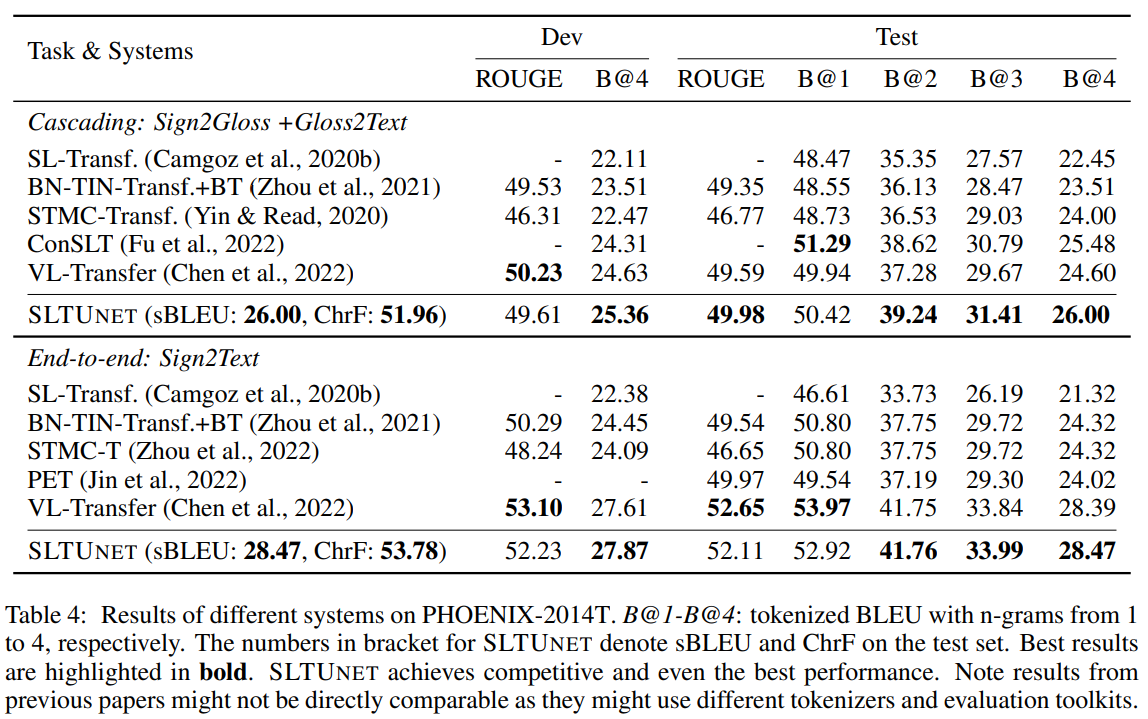Paper | Highlights | Overview | DGS3-T | Training&Eval | Model Performance | Citation
- Update (2023/07/09): We release the trained model for phoenix and csldaily at here. See
infer.shfor details.
Among thousands of languages globally, some are written, some are spoken, while some are signed. Sign languages are unique natural languages widely used in Deaf communities. They express meaning through hand gestures, body movements and facial expressions, and are often in a video form. We refer the readers to Sign language Processing for a better understanding of sign languages.
In this study, we aim at improving sign language translation, i.e. translating information from sign languages (in a video) to spoken languages (in text). We address the video-text modality gap and the training data scarcity issue via multi-task learning and unified modeling.
Briefly,
- We propose a simple unified model, SLTUNET, for SLT, and show that jointly modeling multiple SLT-related tasks benefits the translation.
- We propose a set of optimization techniques for SLTUNET aiming at an improved trade-off between model capacity and regularization, which also helps SLT models for single tasks.
- SLTUNET performs competitively to previous methods and yields the new state-of-the-art performance on CSL-Daily.
- We use the DGS Corpus and propose DGS3-T for end-to-end SLT, with larger scale, richer topics and more significant challenges than existing datasets.
-
Similar to PHOENIX-2014T and CSL-Daily, DGS3-T is a dataset used for the study of SLT, consisting of sign videos and text translations.
-
Different from these previous datasets, DGS3-T is larger at scale, covering broader domains and topics with more signers.
-
DGS3-T represents more practical challenges in SLT. We encourage researchers to consider it for SLT research.
DGS3-T Licensing
DGS3-T is based on the Public DGS Corpus. The license of the Public DGS Corpus does not allow any computational research except if express permission is given by the University of Hamburg.
Constructing DGS3-T
Please check out dgs3-t for details.
The source code is based on older tensorflow.
- python==3.8
- tensorflow==1.15
Training includes two phrase: 1) pretrain sign embeddings; 2) train SLTUNet model.
Please check out example for details.
Check out our paper for more results on CSLDaily and DGS3-T.
- Update (2023/04/02): note, for CSL-Daily, we always adopt subword preprocessing (NOT character) for the target text and gloss sequence during training and inference; We post-process the generated subword sequence into a character sequence at evaluation for char-level BLEU.
If you draw any inspiration from our study, please consider to cite our paper:
@inproceedings{
zhang2023sltunet,
title={{SLTUNET}: A Simple Unified Model for Sign Language Translation},
author={Biao Zhang and Mathias M{\"u}ller and Rico Sennrich},
booktitle={The Eleventh International Conference on Learning Representations },
year={2023},
url={https://openreview.net/forum?id=EBS4C77p_5S}
}

